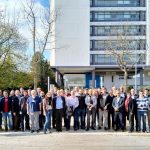Packet-level network measurements in METRO-HAUL
One of the main challenges of the METRO-HAUL project is to implement tools to monitor future 5G metro networks. Such data can be obtained by telemetry from the different network elements, such as optical transponders or SDN controllers. Moreover, packet-level measurements can also be taken from network probes, to contrast their results with optical-layer measurements, providing information that is closer to the users’ experience. However, in order to obtain both accurate and precise measurements at the packet level, it is necessary to develop high-performance equipment that can reach 100 Gbit/s and beyond.
Packet-level measurements can be classified as active and passive measurements. Active measurements are done by injecting traffic at one end of the network, and receiving and measuring it at the other end. Such traffic can range from a simple ping to synthetic traffic resembling real one. Knowing what has been sent, it is possible to measure packet delays and losses. Furthermore, it is also possible to measure other network KPIs, such as network bandwidth capacity. One of the main concerns with active measurements is that they can disturb real traffic, so they are usually taken in situations where there is not such real traffic. For instance, in the METRO-HAUL context they can be useful to know if the control plane has correctly set all network configuration along a path between the metro edge nodes.
When the network links are in operation, passive measurements enter onto the scene. In this case, it is possible to capture the traffic traversing a vantage point, inspecting and accounting the packets based on their headers (addresses and ports) and their lengths. With this information, it is possible to know the packets, bytes, and flows that are on a link at any time. This can be done down to one-second granularity, with details of the incoming and outgoing addresses, which is very useful for network management and planning in multi-layer environments. Passive measurements can also estimate delays from the connection establishment time, as well as losses from connection re-transmissions of existing traffic.
In the context of the METRO-HAUL project, Naudit HPCN is developing highly accurate and precise high-performance network probes that are both active and passive and that work at 100 Gbit/s. To achieve this goal, Naudit leverages its experience building 10 Gbit/s network probes, combined with new approaches to reach the 10x higher rate. At 100 Gbit/s in an Ethernet network, in the most stringent situations, a new packet can arrive every 6.72 ns, which is shorter than current SDRAM technology memory access time. Thus, it is necessary to combine inventive solutions with state-of-the-art high-performance computing technology to deal with this data rate. On the one hand, we are working with the latest Xilinx FPGA platforms to obtain both accurate and precise measurements. On the other hand, we also take advantage of the latest Intel processor architectures with higher parallelism and larger memory bandwidth, combined with fast NVMe drives, directly connected to PCIe bus, to read or store bulk packet data when needed.

A Metro Network Showing Naudit’s Active and Passive Probes
The latest Xilinx FPGA platforms include 100 GE interfaces, so packets can be directly sent or received at the FPGA. The most relevant FPGA characteristic is its deterministic behavior, so any time measurement is going to be correctly measured in clock cycles. Thus, active measurements can be done by sending timestamped packets, which are timestamped again at the receiver, avoiding the uncertainty that appears when using a software-based solution. These solutions also include memory technologies (Block RAM and UltraRAM) that are faster than SDRAM, being able to deal with the traffic even when 148.8 million packets are received per second.
Naudit probes developed in METRO-HAUL are planned to be used in one of the low-latency ultra-reliable use cases, to be deployed for demonstration purposes, conveniently located in the metro edge nodes, as shown in the figure. There, the network probes will be useful to feed the network monitoring and analysis system with packet-level data, combining both active and passive measurements. With this information, the control layer will have valuable data to reconfigure the network when needed and adapt its behavior to the traffic that is traversing the network, and provide the best possible experience to the end users.
———————————————————
Naudit HPCN is a Spanish technology firm devoted to high-performance network monitoring and analysis services and tools. It was founded in 2009 by nine professors together with Universidad Autónoma de Madrid (UAM), Universidad Pública de Navarra (UPNA), and Fundación Parque Científico Madrid. Naudit’s staff is made up by Engineers and PhDs in Telecommunications and Computer Science, and senior IT professionals that come from the business world. Naudit and its partners bring extensive experience in customer projects in Spain and Latin America with telco operators and large companies, as well as research projects conducted both in Spain and the European Union. Naudit premises are located in Spain at Madrid and Pamplona. You can find more information about Naudit at http://www.naudit.es/en/.




